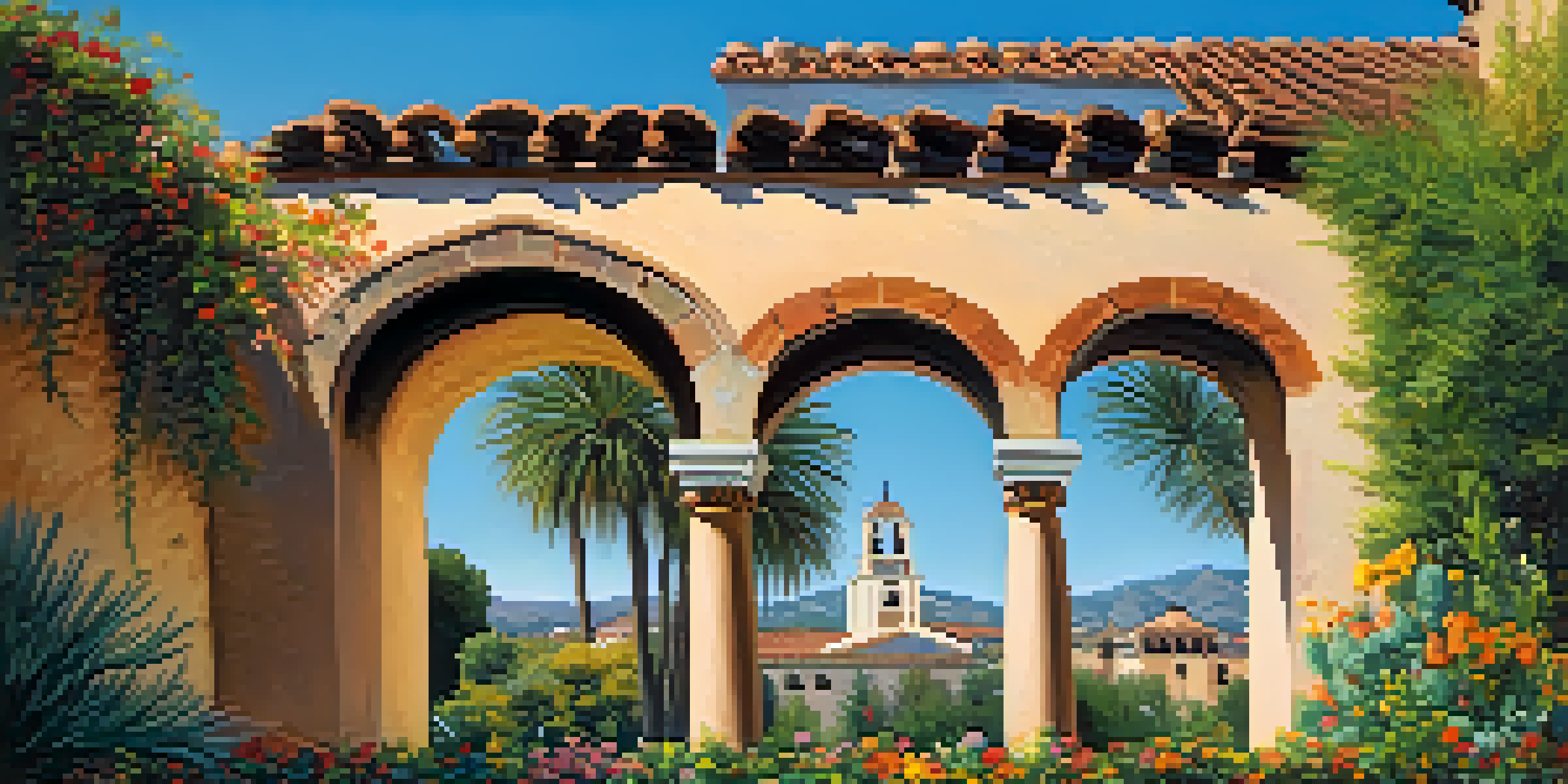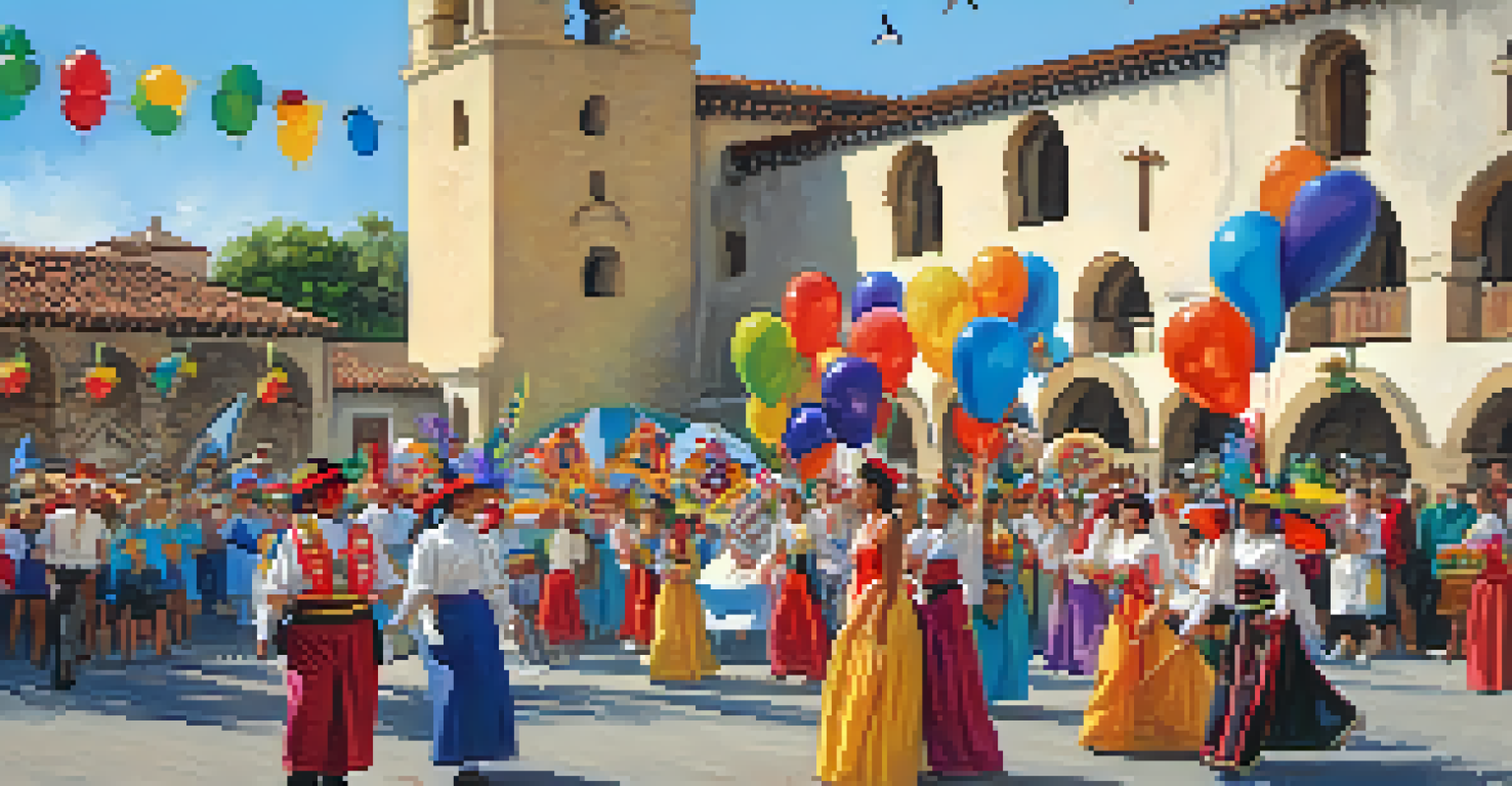Mission San Juan Capistrano: A Cultural and Historical Gem

The Founding of Mission San Juan Capistrano
Founded in 1776, Mission San Juan Capistrano is one of the oldest missions in California. Established by Spanish Franciscan missionaries, it aimed to spread Christianity among the Native American population. The mission is named after Saint John of Capistrano, a 15th-century preacher known for his efforts in the Catholic faith.
The mission is the heart of our community, a place where history and culture come alive.
Over the years, the mission became a vital part of the community, serving both spiritual and educational needs. It played a significant role in the Spanish colonization of California, helping to establish agriculture and trade in the region. The mission's early days were marked by both challenges and triumphs, as it navigated relations with local tribes and adapted to its growing responsibilities.
Today, the mission stands as a testament to this rich history, inviting visitors to explore its beautifully landscaped grounds and historic buildings. It embodies the spirit of resilience and cultural exchange that defined its early years, making it a must-visit for history enthusiasts.
Architectural Wonders of the Mission
The architecture of Mission San Juan Capistrano is a beautiful blend of Spanish Colonial and Native American styles. The iconic bell wall, with its distinctive arches and bells, is among the most photographed elements of the mission. This unique feature not only serves as a visual focal point but also reflects the mission's functional history of calling the faithful to worship.

Inside, visitors can admire the stunning sanctuary adorned with intricate details and vibrant murals. The use of adobe bricks, a traditional building material, provides insight into the construction methods of the time. Each structure within the mission tells a story, showcasing the craftsmanship and artistic influences that shaped its design.
Historical Significance of the Mission
Mission San Juan Capistrano is a vital landmark representing California's rich history and cultural diversity.
As you wander through the mission grounds, you’ll also notice the beautiful gardens filled with native plants. These gardens not only enhance the aesthetic appeal but also symbolize the mission's connection to the land and its agricultural roots.
Cultural Significance and Community Impact
Mission San Juan Capistrano has had a profound impact on the local community, acting as a cultural hub for centuries. It played a crucial role in the development of the area, influencing everything from agriculture to education. The mission's commitment to providing resources and support fostered a sense of community among residents.
Missions are a reminder of our past, a bridge to understanding the diverse cultures that shaped our present.
Moreover, the mission has become a symbol of California's rich multicultural heritage. It represents the blending of Spanish, Native American, and later, Mexican influences, showcasing the diverse history of the region. This cultural tapestry is celebrated through various events and programs held at the mission throughout the year.
Today, the mission continues to engage with the community by offering educational programs, workshops, and cultural events. This ongoing commitment to education and cultural preservation helps to ensure that the legacy of Mission San Juan Capistrano lives on for future generations.
The Swallows and the Mission's Legacy
One of the most charming aspects of Mission San Juan Capistrano is its connection to the swallows that return each year. Every March, these migratory birds make their way back to the mission, a phenomenon celebrated by locals and visitors alike. This annual event not only symbolizes renewal but also connects the mission to nature and the changing seasons.
The return of the swallows has inspired various festivals and celebrations, including the famous Swallows Day Parade. This lively event showcases the community’s spirit, with colorful floats and participants dressed in traditional attire. It’s a wonderful example of how the mission has influenced local culture and traditions.
Architectural Beauty and Design
The mission showcases a stunning blend of Spanish Colonial and Native American architectural styles, with iconic features like the bell wall.
As a result, the swallows have become a symbol of hope and resilience, much like the mission itself. Their presence reminds us of the natural cycles of life and the importance of preserving both cultural and environmental heritage.
Art and Artifacts in the Mission Museum
The Mission San Juan Capistrano Museum houses an impressive collection of artifacts that tell the story of the mission's history. Visitors can explore exhibits featuring religious items, tools used by early settlers, and artworks that reflect the mission's artistic heritage. Each piece provides a glimpse into the daily lives of those who lived and worked at the mission.
One notable artifact is the original bell used at the mission, which has a rich history of its own. The museum also displays historical documents that chronicle the mission's evolution over the years, offering a deeper understanding of its significance in California's history. These artifacts serve as a bridge between the past and present, enriching the visitor experience.
In addition to the artifacts, the museum hosts rotating exhibits that explore different themes related to the mission's history and cultural impact. This commitment to showcasing diverse perspectives ensures that there is always something new to learn and discover at Mission San Juan Capistrano.
Visiting Mission San Juan Capistrano: Practical Tips
If you’re planning a visit to Mission San Juan Capistrano, there are a few practical tips to keep in mind. First, consider purchasing tickets online in advance, especially during peak tourist seasons. This not only saves time but also ensures you don't miss out on exploring this historical gem.
When you arrive, take your time to wander through the lush gardens and historic buildings. Guided tours are available and provide valuable insights into the mission's history and architecture. Don't forget to bring your camera; the picturesque surroundings offer countless photo opportunities.
Community Engagement and Events
The mission actively fosters community engagement through educational programs and cultural events, ensuring its legacy continues.
Lastly, check the mission's calendar for any special events or activities happening during your visit. Participating in a cultural event or workshop can enhance your experience and deepen your appreciation for this beautiful site.
Conclusion: A Lasting Legacy of Mission San Juan Capistrano
Mission San Juan Capistrano stands as a lasting legacy of California's rich history and cultural diversity. Its beautifully preserved architecture and vibrant gardens invite visitors to step back in time and appreciate the contributions of those who came before us. The mission is not just a historical site; it is a living testament to the resilience of the human spirit.
Through its ongoing community engagement and educational programs, the mission continues to inspire and connect people from all walks of life. It serves as a reminder of the importance of preserving our cultural heritage and the stories that shape our identities.

As you explore Mission San Juan Capistrano, take a moment to reflect on its significance in both local and global contexts. This cultural gem offers a unique opportunity to appreciate history, nature, and community all in one beautiful place.